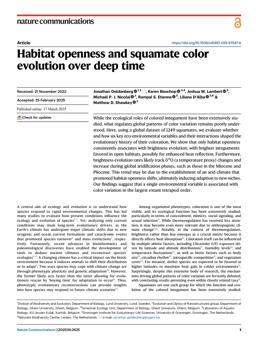2025-03-17
Habitat openness and squamate color evolution over deep time
Publication
Publication
Nature Communications , Volume 16 - Issue 2625
While the ecological roles of colored integument have been extensively studied, what regulates global patterns of color variation remains poorly understood. Here, using a global dataset of 1249 squamates, we evaluate whether and how six key eco-environmental variables and their interactions shaped the evolutionary history of their coloration. We show that only habitat openness consistently associates with brightness evolution, with brighter integuments favored in open habitats, possibly for enhanced heat reflection. Furthermore, brightness evolution rates likely track δ18O (a temperature proxy) changes and increase during global aridification phases, such as those in the Miocene and Pliocene. This trend may be due to the establishment of an arid climate that promoted habitat openness shifts, ultimately inducing adaption to new niches. Our findings suggest that a single environmental variable is associated with color variation in the largest extant tetrapod order.
| Additional Metadata | |
|---|---|
| doi.org/10.1038/s41467-025-57547-6 | |
| Nature Communications | |
| Released under the CC-BY 4.0 ("Attribution 4.0 International") License | |
| Organisation | Staff publications |
|
Goldenberg, Jonathan, Bisschop, Karen, Lambert, Joshua W., Nicolaï, Michaël P. J., Etienne, Rampal S., D'Alba, L., & Shawkey, Matthew D. (2025). Habitat openness and squamate color evolution over deep time. Nature Communications, 16(2625). doi:10.1038/s41467-025-57547-6 |
|
